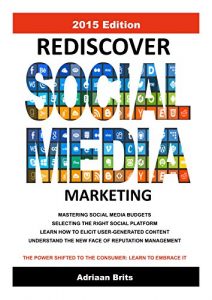This book is dedicated to marketing agencies, sales directors, personal branding practitioners, MBA business students and financial decision makers. The marketing environment evolved to a point where one way marketing messages made way for interactive discussions. Now, even product design and the creation of advertisements developed by companies are also making room for more involvement by consumers. It is foreseeable that stakeholders will form new habits and expectations which will in turn raise minimum requirements for the processes around socially interactive marketing. The reasons for participation in social media marketing depends on the user: Publishers may do so to attract large crowds to their advertising inventory, companies may do so to enhance branding, deliver customer service and co-create with the consumer. The consumer may do so to genuinely participate in a brand, to make their voice heard and out of their need to belong to a community. Today, to succeed in social media marketing, we have to be intuitive: We need to engage, entertain and inform our customers. But what are the most innovative ways to do it – and what proportion of the budget do we allocate towards this?
This publication helps businesses master six critical areas of social media marketing:
1.The link that exists between corporate social media and publishers is an important one that is yet to be exploited by corporate participants in social media.
2. User-generated content is sexy and powerful! Yet it is a curse to businesses who are still grappling to come to terms with the fact that power has shifted from the brand to the consumer. It is now the consumer that has the power – and the brand that needs to work with the consumer. Harassing UGC is the new way forward.
3.Reputation management in a social media age is dealt with differently. Since the consumer now has the power, companies should embrace anarchy and learn that negative feedback can be very good for a corporation if dealt with appropriately.
4.The social media budget: Where do we spend our money? What works, what does not work? How do we measure our success? How do we know that our marketing agency is worth the money they charge?
5.The idea that businesses and publishers have to donate all their business to Facebook and LinkedIn is rather misguided. In fact in many cases it results in slave labour, adding billions to corporations like Facebook INC. Learning how to be social on our own platforms rather than third party platforms is the key to success. The technology is available to achieve this.
6.There is fierce competition on the web to elicit UGC. The case studies we share will reveal the latest tactics used around the web by some of the most successful social platforms.
Given the rise of LinkedIn and other online tools, I felt it was appropriate to include a bonus section on Influencer Marketing, which I hope you will find really useful. The purpose is to look far beyond just Facebook. Instead, we explore key concepts which are applicable to a wide range of social media platforms in order to develop a sustainable and profitable social media strategy.
This publication helps businesses master six critical areas of social media marketing:
1.The link that exists between corporate social media and publishers is an important one that is yet to be exploited by corporate participants in social media.
2. User-generated content is sexy and powerful! Yet it is a curse to businesses who are still grappling to come to terms with the fact that power has shifted from the brand to the consumer. It is now the consumer that has the power – and the brand that needs to work with the consumer. Harassing UGC is the new way forward.
3.Reputation management in a social media age is dealt with differently. Since the consumer now has the power, companies should embrace anarchy and learn that negative feedback can be very good for a corporation if dealt with appropriately.
4.The social media budget: Where do we spend our money? What works, what does not work? How do we measure our success? How do we know that our marketing agency is worth the money they charge?
5.The idea that businesses and publishers have to donate all their business to Facebook and LinkedIn is rather misguided. In fact in many cases it results in slave labour, adding billions to corporations like Facebook INC. Learning how to be social on our own platforms rather than third party platforms is the key to success. The technology is available to achieve this.
6.There is fierce competition on the web to elicit UGC. The case studies we share will reveal the latest tactics used around the web by some of the most successful social platforms.
Given the rise of LinkedIn and other online tools, I felt it was appropriate to include a bonus section on Influencer Marketing, which I hope you will find really useful. The purpose is to look far beyond just Facebook. Instead, we explore key concepts which are applicable to a wide range of social media platforms in order to develop a sustainable and profitable social media strategy.






